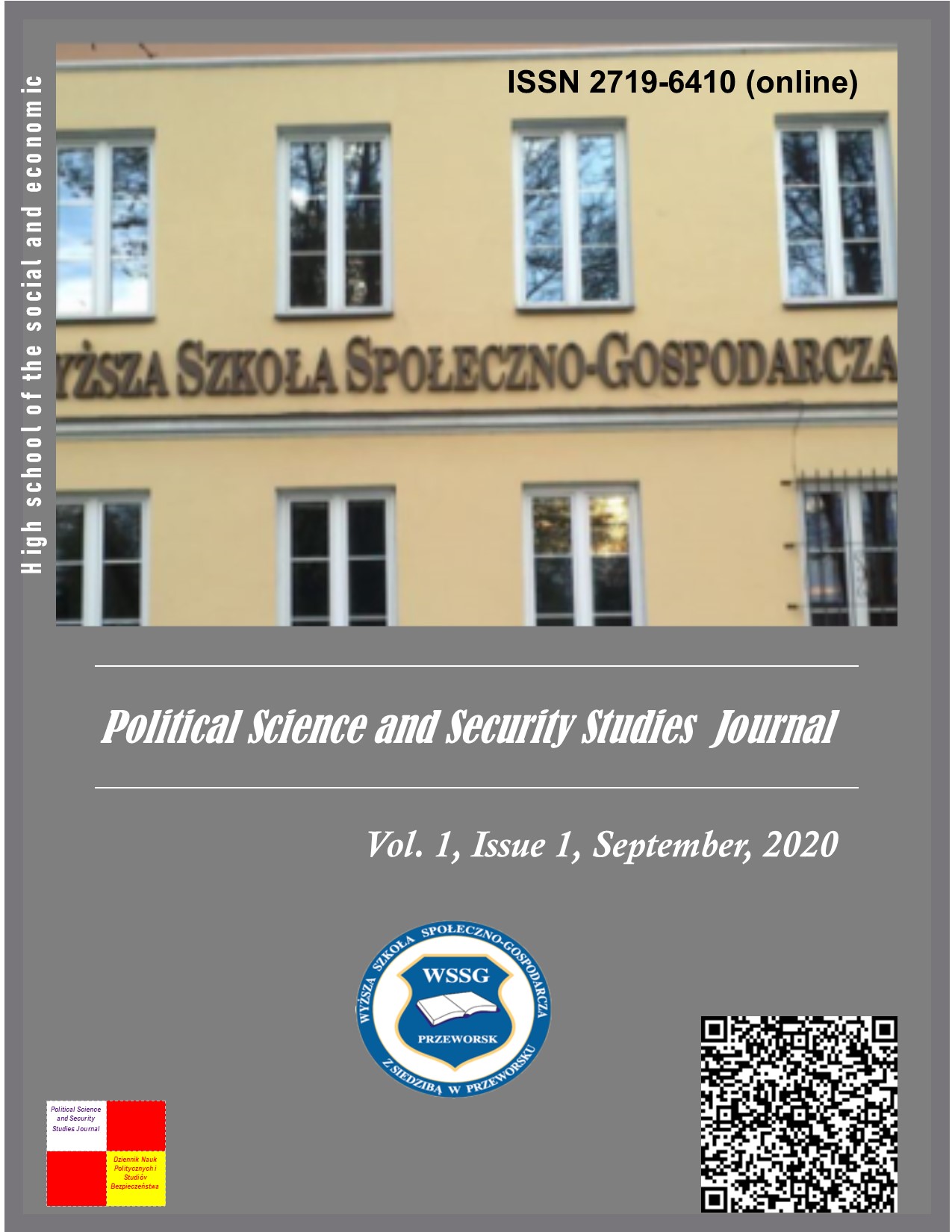The estimating method of probability of radar’s suppression at the position
DOI:
https://doi.org/10.5281/zenodo.4543609Keywords:
radar’s suppression, estimating method, theoretical-game modelAbstract
The article presents an approach to estimating the probability of suppression of a radar station at a position as a consequence of combat use. The idea of the technique is based on the description of stochastic characteristics of the enemy’s ability to expose, identify the radar at the position or in the process of maneuvering and, accordingly, the issuance of information to the means of fire (electronic) suppression.
The presented technique is analytical and is based on a simplified theoretical-game model of the conflict situation “Radar – means of reconnaissance of the enemy”, provides a forecast of the probability of electronic and fire impact on the radar within certain positions. The evaluation criterion is the minimum value of the probability of suppression of the radar station by options. The convenience of the described approach is determined by its simplicity and clear logic in determining the formal consequences of the accepted hypotheses and assumptions in the formation of the forecast of the results of combat use of the radar station. The methodology is of a recommendatory nature and can be used in the work of the relevant authorities in forecasting the loss of troops.
Downloads
References
Radecjkyj, V. Gh., Rusnak, I. S. Shhypansjkyj, P. V. (2008), “Protypovitrjana oborona u lokaljnykh vijnakh i zbrojnykh konfliktakh: navachljno-metodychnyj posibnyk” [The air defense of local wars and armed conflicts], National Defense Academi of Ukraine, Kyiv, 254 p. [in Ukrainian]
Radecjkyj, V. Gh., Rusnak, I. S. Zagorka, O. V. (2007), “Metodologichni zasady obgruntuvannya racionalnyx form ta sposobiv zastosuvannya ugrupovan vijsk (syl)” [Methodological principles of justification of rational forms and methods groups of troops (forces) using], National Defense University of Ukraine, Kyiv, 288 p. [in Ukrainian].
Ghorodnov, V. P., Gh. Drobakha, A. M., Jermoshyn, O. М. (2004), “Modeljuvannja bojovykh dij vijsjk (syl) protypovitrjanoji oborony ta informacijne zabezpechennja procesiv upravlinnja nymy (teorija, praktyka, istorija rozvytku)” [Methodological principles of justification of rational forms and methods groups of troops (forces) using], KhUPS, Kharkiv, 409 p. [in Ukrainian].
Zaghorka, O. M., Romanchenko, I. S., Butenko, S. Gh. and Dejnegha, O. V. (2011), “Teorija i praktyka borotjby z malorozmirnymy nyzjkolitnymy ciljamy (ocinka mozhlyvostej, tendenciji rozvytku zasobiv PPO): monohrafiia” [The theory and practice of combating small-scale low-caliber purposes (assessment of opportunities, tendencies of development of means of air defense], Polissya, Zhytomyr, 344 p. [in Ukrainian].
Yarosh, S. P. (2012), “Teoretychni osnovy pobudovy ta zastosuvannia rozviduvalno-upravliaiuchykh informatsiinykh system protypovitrianoi oborony” [Theoretical foundations of the construction and application of intelligence-control information systems of air defense], KhUPS, Kharkiv, 512 p. [in Ukrainian].
Snycarenko, P. M. (2010). “Metodycheskye osnovy obosnovanyja trebovanyj k voennym systemam dystancyonnogho monytoryngha okruzhajushhegho prostranstva dlja vyjavlenyja y soprovozhdenyja podvyzhnykh ob’ektov pry uslovyy resursnykh oghranychenyj na ykh sozdanye” [Methodical bases of requirements substantiation for military systems of the surrounding space remote monitoring for identifying and tracking moving objects, subject to resource constraints on their creation]. Prykladnaja radyoelektronyka – Applied radioelectronics, No. 3, pp. 229–241.
Pavlenko, M. A. Hohoniants, S. Yu., and Polishhuk, S. V. (2017). “Podkhod k ocenyvanyju effektyvnosty radyolokacyonnogho obespechenyja potrebytelej dlja kontrolja vozdushnogho prstranstva” [Approach to evaluating the effectiveness of consumer radar to control airspace]. Uraljskyj nauchnyj vestnyk – Оралдын гылым жаршысы, No. 1(161), pp. 86–94.
Barabash, O., Hohoniants, S. and Titarenko, S. (2015), “The simplest model of functioning a separate element of the executive system when solving typical tasks”, Riadenie bezpečnosti zložitých systémov, Akadémia ozbrojených síl generála Milana Rastislava Štefánika, No. 1, pp. 153–158.
Hohoniants, S. Yu., & Polishhuk, S. V. (2016). “Zaghaljni polozhennja udoskonalenoji metodyky ocinky efektyvnosti radiolokacijnogho zabezpechennja bojovykh dij ughrupovannja syl i zasobiv protypovitrjanoji oborony” [General provisions of the advanced methodology for assessing the efficiency of the air defense forces radar support]. Nauka i tekhnika Povitrjanykh Syl – Science and Technology of the Air Force of Ukraine, No. 4 (25), pp. 70–73. [in Ukrainian].
Hohoniants, S. Yu., and Polishhuk, S. V. (2016). “Obgruntuvannja intensyvnostej zminy funkcionaljnykh staniv mobiljnogho radiolokacijnogho kompleksu” [Change intensity substantiation of mobile radar complex functional states]. Nauka i tekhnika Povitrjanykh Syl – Science and Technology of the Air Force of Ukraine, No. 3 (24), pp. 90–92. [inUkrainian].
Hohoniants, S. Ju. and Polishuk, S. V. (2016), “Dekompozycija elementarnogho procesu radiolokacijnogho zabezpechennja” [The decomposition of the elementary radar process], Modern Information Technologies in the Sphere of Security and Defence, No. 1, pp. 20-23. [in Ukrainian].
Hohoniants, S. Yu., & Polishhuk, S. V. (2016). Model radiolokacijnogho zabezpechennja bojovykh dij ughrupovannja syl i zasobiv protypovitrjanoji oborony v operacijakh [Combat operations radar support model of the forces grouping and air defense means in operations]. Infomation Processing Systems, No. 3 (130), pp. 126-130. [in Ukrainian].
Published
How to Cite
Issue
Section
License
The authors agree with the following conditions:
1. Authors retain copyright and grant the journal right of first publication (Download agreement) with the work simultaneously licensed under a Creative Commons Attribution License that allows others to share the work with an acknowledgment of the work's authorship and initial publication in this journal.
2. Authors have the right to complete individual additional agreements for the non-exclusive spreading of the journal’s published version of the work (for example, to post work in the electronic repository of the institution or to publish it as part of a monograph), with the reference to the first publication of the work in this journal.
3. Journal’s politics allows and encourages the placement on the Internet (for example, in the repositories of institutions, personal websites, SSRN, ResearchGate, MPRA, SSOAR, etc.) manuscript of the work by the authors, before and during the process of viewing it by this journal, because it can lead to a productive research discussion and positively affect the efficiency and dynamics of citing the published work (see The Effect of Open Access).















